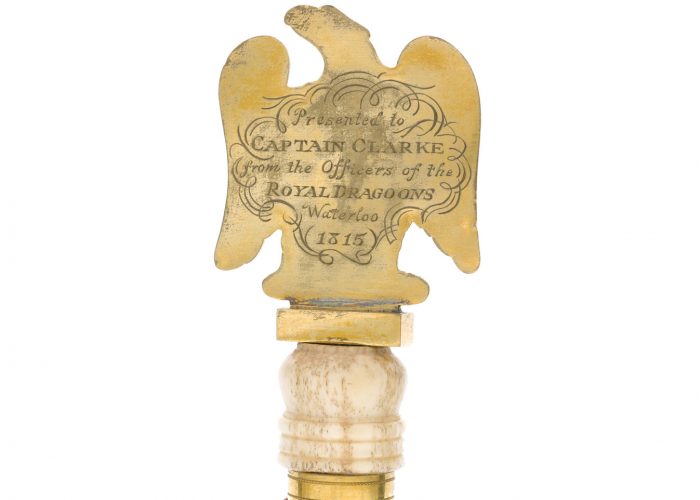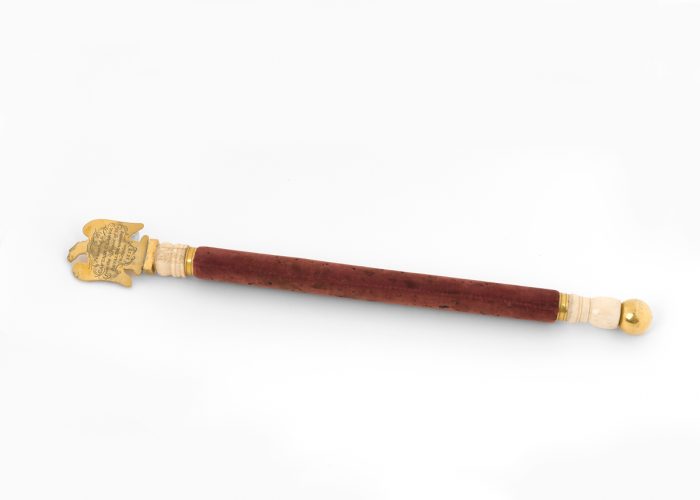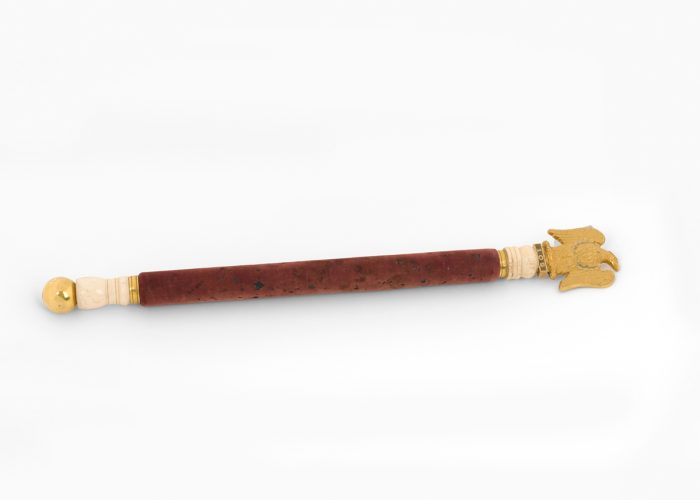Captain Alexander Kennedy Clark’s Waterloo baton


 Baton presented to Captain Alexander Kennedy Clarke from the officers of the 1st (or Royal) Dragoons commemorating the capture of a French eagle, 1815 (c).
Baton presented to Captain Alexander Kennedy Clarke from the officers of the 1st (or Royal) Dragoons commemorating the capture of a French eagle, 1815 (c).
 Baton presented to Captain Alexander Kennedy Clarke from the officers of the 1st (or Royal) Dragoons commemorating the capture of a French eagle, 1815 (c)
Baton presented to Captain Alexander Kennedy Clarke from the officers of the 1st (or Royal) Dragoons commemorating the capture of a French eagle, 1815 (c)
 Baton presented to Captain Alexander Kennedy Clarke from the officers of the 1st (or Royal) Dragoons commemorating the capture of a French eagle, 1815 (c)
Baton presented to Captain Alexander Kennedy Clarke from the officers of the 1st (or Royal) Dragoons commemorating the capture of a French eagle, 1815 (c)
The baton presented to Captain Kennedy Clark for his much-debated role in the capture of a French regimental eagle at Waterloo
This baton was presented to Captain Alexander Kennedy Clark by his Regiment, the 1st (or Royal) Regiment of Dragoons, after the Battle of Waterloo during which he, by his own account, captured the Eagle of 105th Regiment de Ligne.
There is some controversy regarding this incident. At Waterloo Captain Kennedy commanded the centre squadron of The Royals which as part of the Union Brigade charged the attacking columns of French Infantry at about 2pm. The regiment some 900 strong belonged to General Bourgeois’ 2nd Brigade and the Royals wreaked havoc amongst the regiment. Captain Clark spotted the “Eagle” of the regiment and made a beeline for it. These were desirable trophies of war.
Clark later said: “When I first saw it, it was perhaps forty yards to my left and a little in front…I gave the order to my squadron, “right shoulders forward, attack the colour” leading direct on the point myself. On reaching it, I ran my sword into the officer’s right side a little above the hip joint. He was a little to my left side and he fell to that side with the Eagle across my horse’s head. I tried to catch it with my left hand, but could only touch the fringe of the flag and it is probably it would have fallen to the ground had it not been prevented by the neck of Corporal Styles’ horse who came up close on my left at the instant and against which it fell. Corporal Styles was the Standard Coverer; his post was immediately behind me and his duty to follow wherever I led. When I first saw the Eagle…and on running the officer through I called out twice ‘secure the colour, secure the colour, it belongs to me.’ This order was addressed to some men close to me [including Corporal Styles]…I endeavoured to break the eagle from off the pole with the intention of putting it into the breast of my coat; but I could not break it, Corporal Styles said ‘ pray Sir do not break it’ on which I replied ‘ Very well, carry it to the rear as fast as you can, it belongs to me.”
It can be seen that in the confusion of battle other versions may have been told. Captain Clark continued to fight and received two wounds and had two horses killed under him, forcing him to retire and it was only then that he made his claim on the Eagle. In the meantime Corporal Styles was credited with the trophy but this was soon corrected. Styles in his account of the action in a letter dated 31 January 1816 makes no mention of Clark. Suffice to say this became a regimental bone of contention and it is hard to see how anybody now can relate exactly what happened. It is surprising perhaps, in these circumstances that Clark was presented with such a fine gift as this baton.
Clark subsequently added Kennedy to his name for inheritance reasons and incorporated the eagle within his coat of arms. He ended up as a Lieutenant General with the KCB and KH (Knight of Guelphic Order of Hanover) and died in 1864. He is buried in St Michael’s Churchyard, Dumfries. Corporal Styles received an ensign’s commission in the 6th West Indian Regiment for his day’s work but was placed on half pay in 1817 and died in London in 1828.
The baton has not been widely known about and was recently acquired by The National Army Museum who also have the Eagle of the 105th Regiment (also in the Waterloo 200 website’s Waterloo object collection). The famous Pieneman painting of Waterloo shows Clark hoisting the eagle on the far left.
-
Curatorial info
- Originating Museum: National Army Museum, London
- Accession Number: NAM. 2016-01-23-1
- Original record
-
Use this image
You can download and use the high resolution image for use in a non-profit environment such as a school or college, but please take note of the license type and rights holder information below
- Rights Holder: National Army Museum, London
- License Type: All Rights Reserved





